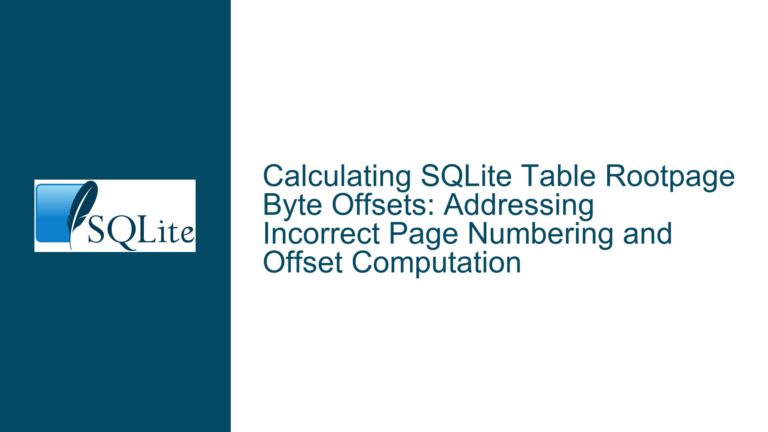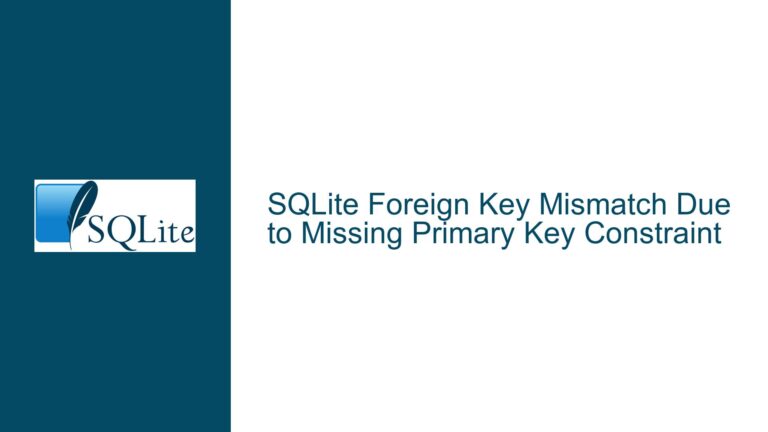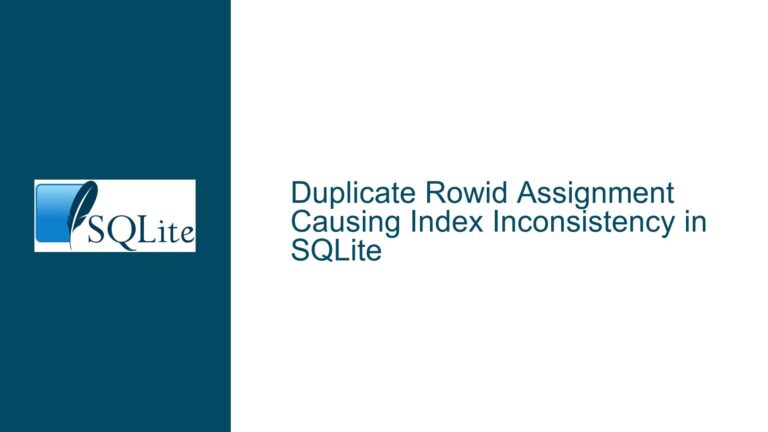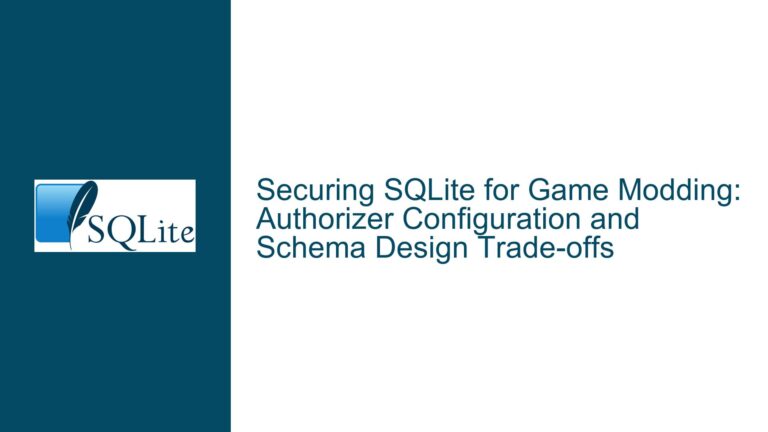Evaluating SQLite for High-Concurrency CMMS Web Applications with Large Datasets
Assessing SQLite’s Viability in High-User Environments with Substantial Data Growth
SQLite’s Architecture and Workload Compatibility in Enterprise CMMS Systems
The core challenge revolves around determining whether SQLite can sustain a web-based CMMS (Computerized Maintenance Management System) supporting 1,000 concurrent users performing CRUD operations on a database containing 45 tables, some exceeding 385,000 rows with incremental data growth. The critical factors to dissect include SQLite’s concurrency model, write scalability, durability guarantees, and optimization strategies for large datasets. Unlike client-server databases such as PostgreSQL or SQL Server, SQLite operates as an embedded library with a serverless, file-based architecture. This design imposes inherent constraints on write parallelism, connection handling, and transaction isolation, which must be weighed against the application’s requirements. The absence of a dedicated server process means all database operations occur within the application’s process space, requiring meticulous configuration to avoid contention, lock conflicts, and performance degradation under heavy loads. Key considerations include the frequency of write operations per user, the ratio of reads to writes, the size of transactions, and the tolerance for latency during peak usage.
A CMMS typically involves frequent updates to work orders, asset maintenance records, and inventory logs, which can generate sustained write pressure. SQLite’s single-writer model serializes all write transactions, creating a potential bottleneck when multiple users attempt simultaneous modifications. For instance, if 10% of the 1,000 concurrent users execute write operations every second, the database must process 100 writes per second. While SQLite can handle this throughput on modern hardware, the latency introduced by lock contention and retries might exceed acceptable thresholds for real-time responsiveness. Additionally, the gradual growth of tables to hundreds of thousands of rows necessitates efficient indexing strategies and query optimization to prevent full-table scans or index bloat. The interplay between schema design, connection pooling, and pragma settings (e.g., journal_mode=WAL, synchronous=NORMAL) becomes pivotal in mitigating these challenges.
Concurrency Bottlenecks, Lock Contention, and Durability Trade-Offs
The primary risks stem from SQLite’s transaction locking mechanism, which grants exclusive write access to a single connection while blocking others. In a high-concurrency web environment, this can lead to frequent SQLITE_BUSY errors unless properly managed. The default rollback journal mode exacerbates this issue by locking the entire database during writes, whereas Write-Ahead Logging (WAL) allows concurrent reads and a single write. However, even with WAL enabled, write transactions must still be serialized, creating contention when multiple threads or processes attempt simultaneous updates. For example, a user updating a maintenance record might block another user trying to log inventory changes, leading to queueing delays. This problem intensifies with increased write parallelism, making it critical to structure transactions to be short-lived and atomic.
Another concern is the durability-safety trade-off inherent in PRAGMA synchronous configurations. Setting synchronous=NORMAL improves write performance by bypassing full fsync operations but risks data loss if the operating system crashes or loses power before the WAL file is fully persisted to disk. In a CMMS context, where maintenance histories and compliance records are mission-critical, partial data loss might be unacceptable, necessitating synchronous=FULL at the cost of reduced throughput. Furthermore, inadequate configuration of mmap_size can lead to excessive I/O overhead, as SQLite defaults to heap-based page caching, which is less efficient than memory-mapped I/O for large datasets. Connections that do not reuse cached pages or fail to leverage shared memory regions may trigger unnecessary disk reads, degrading response times.
Optimizing SQLite for Scalable CMMS Deployments: Configuration, Monitoring, and Fallback Strategies
To maximize SQLite’s performance in this scenario, begin by enabling Write-Ahead Logging (PRAGMA journal_mode=WAL), which decouples reads from writes and reduces contention. Combine this with PRAGMA mmap_size=268435456 (or higher) to allocate 256MB of virtual memory for memory-mapped I/O, reducing physical disk access. Set PRAGMA busy_timeout=5000 to enforce a 5-second retry period for busy connections, preventing abrupt failures and allowing queued transactions to resolve gracefully. For write transactions, explicitly use BEGIN IMMEDIATE to acquire a reserved lock upfront, minimizing the window for contention. Ensure all database connections are pooled and reused to avoid the overhead of repeatedly opening and closing file handles.
Monitor performance metrics such as transaction latency, lock wait times, and checkpoint stalls using SQLite’s sqlite3_status() API or third-party tools. Implement connection-level logging to identify long-running transactions or queries that trigger full-table scans. For tables exceeding 500,000 rows, audit index coverage and consider covering indexes to eliminate unnecessary row lookups. For example, a query filtering work orders by status and priority should have a composite index on (status, priority) to avoid scanning the entire table. Partition large tables by time or category to limit the scope of queries and maintenance operations. If write throughput remains insufficient despite optimizations, introduce a queuing layer to batch updates or offload non-critical writes to a background process.
Evaluate the feasibility of sharding the database by organizational department or geographic location, though this complicates cross-shard queries. As a fallback, design the application with an abstraction layer that allows migrating to PostgreSQL or SQL Server with minimal code changes. Use database-agnostic ORM tools or separate the storage engine from the business logic. Conduct load testing with tools like Apache JMeter or Locust to simulate 1,000 users performing typical CMMS operations, gradually increasing the load until performance thresholds are breached. If SQLite cannot meet the required SLAs under peak load, transition to a client-server database while retaining SQLite for edge caching or offline functionality.





